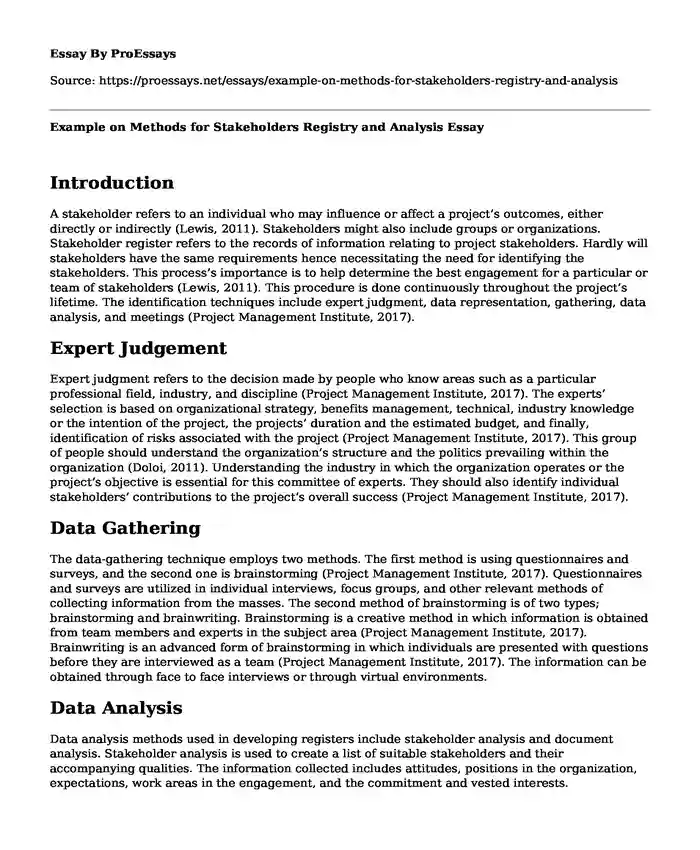Introduction
A stakeholder refers to an individual who may influence or affect a project’s outcomes, either directly or indirectly (Lewis, 2011). Stakeholders might also include groups or organizations. Stakeholder register refers to the records of information relating to project stakeholders. Hardly will stakeholders have the same requirements hence necessitating the need for identifying the stakeholders. This process’s importance is to help determine the best engagement for a particular or team of stakeholders (Lewis, 2011). This procedure is done continuously throughout the project’s lifetime. The identification techniques include expert judgment, data representation, gathering, data analysis, and meetings (Project Management Institute, 2017).
Expert Judgement
Expert judgment refers to the decision made by people who know areas such as a particular professional field, industry, and discipline (Project Management Institute, 2017). The experts’ selection is based on organizational strategy, benefits management, technical, industry knowledge or the intention of the project, the projects’ duration and the estimated budget, and finally, identification of risks associated with the project (Project Management Institute, 2017). This group of people should understand the organization’s structure and the politics prevailing within the organization (Doloi, 2011). Understanding the industry in which the organization operates or the project’s objective is essential for this committee of experts. They should also identify individual stakeholders’ contributions to the project’s overall success (Project Management Institute, 2017).
Data Gathering
The data-gathering technique employs two methods. The first method is using questionnaires and surveys, and the second one is brainstorming (Project Management Institute, 2017). Questionnaires and surveys are utilized in individual interviews, focus groups, and other relevant methods of collecting information from the masses. The second method of brainstorming is of two types; brainstorming and brainwriting. Brainstorming is a creative method in which information is obtained from team members and experts in the subject area (Project Management Institute, 2017). Brainwriting is an advanced form of brainstorming in which individuals are presented with questions before they are interviewed as a team (Project Management Institute, 2017). The information can be obtained through face to face interviews or through virtual environments.
Data Analysis
Data analysis methods used in developing registers include stakeholder analysis and document analysis. Stakeholder analysis is used to create a list of suitable stakeholders and their accompanying qualities. The information collected includes attitudes, positions in the organization, expectations, work areas in the engagement, and the commitment and vested interests. Stakeholders’ stakes revolve around interest, rights, ownership, knowledge, and contribution (Doloi, 2011). Particular expertise on the project is required for the specific project that will undoubtedly be necessary for the stakeholders. Contributions towards an assignment may also be an essential factor in stakeholder analysis (Doloi, 2011). Stakeholders can also be identified by document analysis through information sourced from the project’s documents.
Data Representation
Data representation techniques used to identify stakeholders and update registers include grids of power to interest, impact on influencing, or ability to influence (Project Management Institute, 2017). Oher representation methods are stakeholder cube, the salience representation, directions of influence, and priority considerations. Power/interest grid, impact/influence grid, or power/influence grid are processes used to group stakeholders according to their authority, influence, and potential to affect the project. Stakeholder cube is used to identify the stakeholder community that will assist in developing strategies for the project. Directions of influence classify stakeholders according to their impact on the project while prioritization is used where there is a large group of stakeholders.
Meetings
These are essential forums for singling out crucial project stakeholders. They can be carried out as small teams with guided discussions, facilitation workshops, or social media through technological means (Project Management Institute, 2017). The ideas and information shared is analyzed to determine suitable stakeholder qualities.
References
Doloi, H. K. (2011). Understanding stakeholders’ perspective of cost estimation in project management. International journal of project management, 29(5), 622-636. https://doi.org/10.1016/j.ijproman.2010.06.001
Project Management Institute. (2017). A Guide to the project management body of knowledge: PMBOK (R) guide. (6th ed.) Project Management Institute.
Lewis, J. P. (2011). Project planning, scheduling & control: The ultimate hands-on guide to bringing projects in on time and budget. McGraw-Hill.
Cite this page
Example on Methods for Stakeholders Registry and Analysis. (2024, Jan 06). Retrieved from https://proessays.net/essays/example-on-methods-for-stakeholders-registry-and-analysis
If you are the original author of this essay and no longer wish to have it published on the ProEssays website, please click below to request its removal:
- Personal Essay Example - My Leadership Experience
- Wine Producing Regions in the World Essay
- Ingredients of Effective Leadership Paper Example
- Essay Sample on Strategies Used by Adidas Group to Enter New Markets
- Essay Example on 180 Years of Automotive Excellence: Chrysler Automobiles
- Nelson Mandela: Charismatic Leader of Hope, Humility, and Positivity - Essay Sample
- Essay Example: Maximizing Profits with Unique Management Tactics & Leadership Styles







